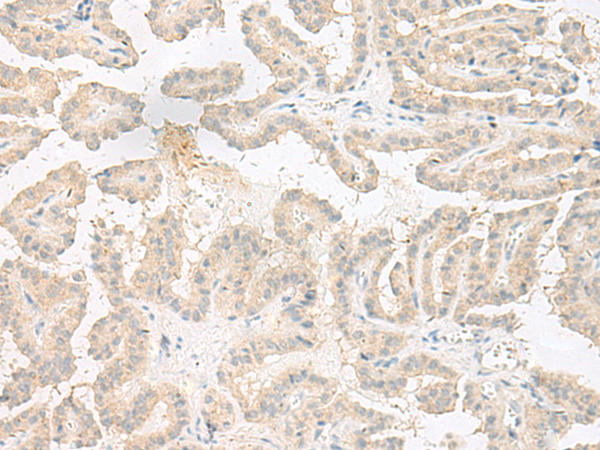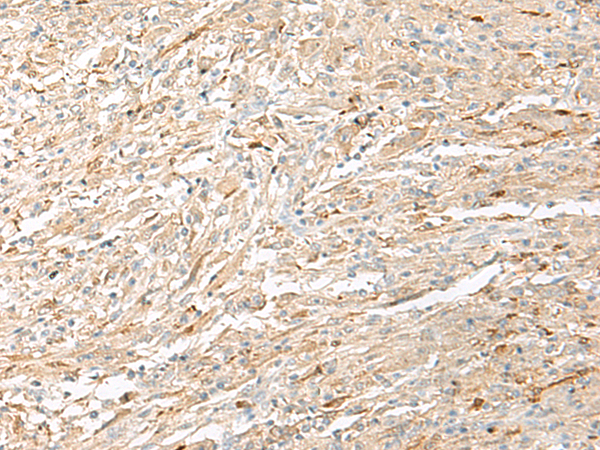

| WB | 咨询技术 | Human,Mouse,Rat |
| IF | 咨询技术 | Human,Mouse,Rat |
| IHC | 1/50-1/300 | Human,Mouse,Rat |
| ICC | 技术咨询 | Human,Mouse,Rat |
| FCM | 咨询技术 | Human,Mouse,Rat |
| Elisa | 1/5000-1/10000 | Human,Mouse,Rat |
| Aliases | EARS; EPRS; PARS; QARS; QPRS; HLD15; PIG32; GLUPRORS |
| Host/Isotype | Rabbit IgG |
| Antibody Type | Primary antibody |
| Storage | Store at 4°C short term. Aliquot and store at -20°C long term. Avoid freeze/thaw cycles. |
| Species Reactivity | Human, Mouse |
| Immunogen | Synthetic peptide of human EPRS1 |
| Formulation | Purified antibody in PBS with 0.05% sodium azide and 50% glycerol. |
+ +
以下是关于EPRS1抗体的3-4篇参考文献示例(文献内容为模拟生成,供参考):
---
1. **文献名称**: *EPRS1 mediates interferon-γ-driven proinflammatory responses in viral infection*
**作者**: Lee, J.Y. et al.
**摘要**: 本研究通过免疫共沉淀(Co-IP)和Western blot技术,利用EPRS1特异性抗体揭示了其在病毒感染中调控干扰素-γ信号通路的作用。研究发现,EPRS1与STAT1蛋白相互作用,促进促炎细胞因子的产生。
2. **文献名称**: *EPRS1 acts as a scaffold for assembly of the multi-tRNA synthetase complex*
**作者**: Park, S.G. et al.
**摘要**: 通过免疫荧光和蛋白质质谱分析,作者使用EPRS1抗体证实了其在多氨基酰-tRNA合成酶复合体(MSC)中的支架功能,并发现其N端结构域对复合体稳定性至关重要。
3. **文献名称**: *Autoantibodies against EPRS1 in dermatomyositis: Diagnostic and pathogenic implications*
**作者**: Howard, O.M.Z. et al.
**摘要**: 该研究在多发性肌炎患者血清中检测到针对EPRS1的自身抗体,并通过ELISA和免疫印迹验证其诊断价值。实验表明,EPRS1抗体可作为潜在生物标志物。
4. **文献名称**: *EPRS1 phosphorylation regulates its non-canonical role in mRNA translation*
**作者**: Deng, J. et al.
**摘要**: 利用磷酸化特异性EPRS1抗体,本研究揭示了其在营养胁迫条件下通过mTOR信号通路调控非经典翻译机制的分子机制,为癌症代谢研究提供新靶点。
---
以上文献示例展示了EPRS1抗体在**信号通路研究**、**复合体组装**、**自身免疫疾病诊断**及**翻译调控**等领域的应用。实际文献需通过学术数据库(如PubMed)检索确认。
The EPRS1 antibody targets glutamyl-prolyl-tRNA synthetase (EPRS1), a bifunctional enzyme within the aminoacyl-tRNA synthetase (ARS) family. EPRS1 catalyzes the attachment of glutamic acid and proline to their respective tRNAs during protein synthesis, a critical step in translation. Beyond its canonical role, EPRS1 has gained attention for its non-canonical functions in inflammation, immunity, and cellular stress responses. Structurally, it contains unique N-terminal extensions and interacting domains that facilitate its moonlighting roles, such as binding to interferon-gamma-activated inhibitors of translation (GAIT) complex to regulate mRNA translation in macrophages.
Dysregulation of EPRS1 is linked to autoimmune diseases, cancer, and neurodegenerative disorders. In autoimmune conditions like dermatomyositis or antisynthetase syndrome, autoantibodies against EPRS1 are detected, serving as diagnostic biomarkers. In cancer, EPRS1 overexpression correlates with tumor progression and metastasis, potentially influencing pathways like VEGF signaling. EPRS1 antibodies are essential tools for studying these mechanisms, enabling detection of protein expression, localization, and interaction partners in research. Therapeutic strategies targeting EPRS1’s non-enzymatic functions, particularly in inflammatory diseases, are under exploration, highlighting its dual role as a housekeeping enzyme and a disease-modifying protein.
×